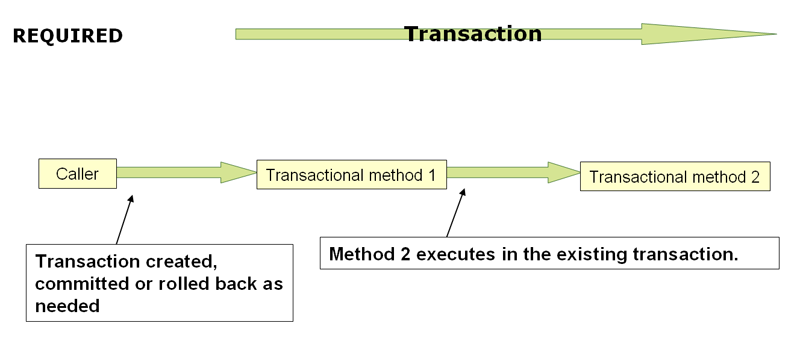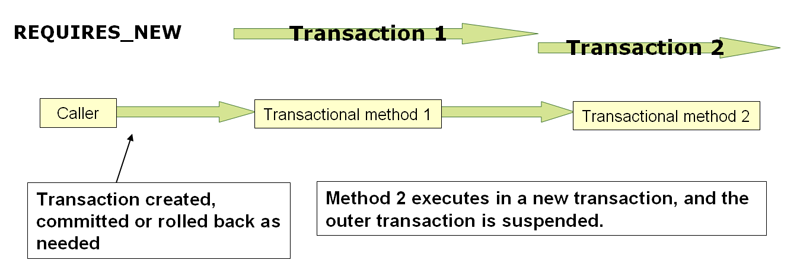事务传播
本节描述了 Spring 中事务传播的一些语义。请注意,本节并非对事务传播的适当介绍。相反,它详细阐述了 Spring 中事务传播的一些语义。在 Spring 管理的事务中,请注意物理事务和逻辑事务之间的区别,以及传播设置如何应用于此区别。
理解 PROPAGATION_REQUIRED

PROPAGATION_REQUIRED 强制执行一个物理事务,如果尚不存在事务,则在当前作用域内本地执行;如果存在为更大作用域定义的“外部”事务,则参与该事务。这在同一线程内的常见调用堆栈安排中是一个很好的默认设置(例如,一个服务门面委托给多个存储库方法,其中所有底层资源都必须参与服务级事务)。
|
默认情况下,参与事务会加入外部作用域的特性,默默地忽略本地隔离级别、超时值或只读标志(如果有)。如果你希望在参与具有不同隔离级别的现有事务时拒绝隔离级别声明,请考虑将事务管理器上的 |
当传播设置为 PROPAGATION_REQUIRED 时,对于应用了该设置的每个方法,都会创建一个逻辑事务作用域。每个这样的逻辑事务作用域都可以单独确定回滚状态,外部事务作用域在逻辑上独立于内部事务作用域。在标准 PROPAGATION_REQUIRED 行为的情况下,所有这些作用域都映射到同一个物理事务。因此,在内部事务作用域中设置的回滚标记确实会影响外部事务实际提交的机会。
然而,在内部事务作用域设置回滚标记的情况下,外部事务尚未自行决定回滚,因此(由内部事务作用域默默触发的)回滚是意料之外的。此时会抛出相应的 UnexpectedRollbackException。这是预期的行为,这样事务的调用者永远不会被误导地认为已执行了提交而实际上没有。因此,如果一个内部事务(外部调用者不知道)默默地将事务标记为回滚,外部调用者仍然会调用提交。外部调用者需要收到 UnexpectedRollbackException 以明确指出已执行了回滚。
理解 PROPAGATION_REQUIRES_NEW

PROPAGATION_REQUIRES_NEW 与 PROPAGATION_REQUIRED 相反,总是为每个受影响的事务作用域使用一个独立的物理事务,从不参与外部作用域的现有事务。在这种安排中,底层资源事务是不同的,因此可以独立提交或回滚,外部事务不受内部事务回滚状态的影响,内部事务的锁在其完成后立即释放。这种独立的内部事务还可以声明自己的隔离级别、超时和只读设置,而不继承外部事务的特性。
|
附加到外部事务的资源将保持绑定在那里,而内部事务将获取自己的资源,例如新的数据库连接。这可能导致连接池耗尽,如果多个线程具有活动的外部事务并等待为其内部事务获取新连接,而池无法再提供任何此类内部连接,则可能导致死锁。除非你的连接池大小适当,超过并发线程数至少 1 个,否则不要使用 |
理解 PROPAGATION_NESTED
PROPAGATION_NESTED 使用单个物理事务和多个保存点,它可以回滚到这些保存点。这种部分回滚允许内部事务作用域为其作用域触发回滚,而外部事务能够继续物理事务,尽管有些操作已被回滚。此设置通常映射到 JDBC 保存点,因此它仅适用于 JDBC 资源事务。请参阅 Spring 的
DataSourceTransactionManager。